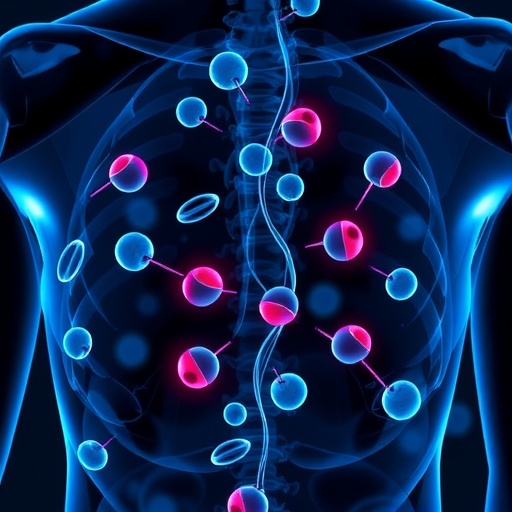Scientists have discovered a group of materials which could pave the way for a new generation of high-efficiency lighting, solving a quandary which has inhibited the performance of display technology for decades. The development of energy saving concepts in display and lighting applications is a major focus of research, since a fifth of the world's electricity is used for generating light.
Writing in Science this week, the team, from the University of Cambridge, the University of East Anglia and the University of Eastern Finland, describes how it developed a new type of material that uses rotatable molecules to emit light faster than has ever been achieved before. It could lead to televisions, smart-phone displays and room lights which are more power-efficient, brighter and longer lasting than those currently on the market.
Corresponding author, Dr Dan Credgington, of the University of Cambridge's Cavendish Laboratory, says: "It's amazing that the very first demonstration of this new kind of material already beats the performance of technologies which have taken decades to develop. If the effect we have discovered can be harnessed across the spectrum, it could change the way we generate light."
Molecular materials are the driving force behind modern organic light-emitting diodes (OLEDs). Invented in the 1980s, these devices emit light when electricity is applied to the organic (carbon based) molecules in them. OLED lighting is now widely used in televisions, computers and mobile phones. However it has to overcome a fundamental issue which has limited efficiency when it comes to converting electrical energy into light.
Passing an electric current through these molecules puts them into an excited state, but only 25% of these are 'bright' states that can emit light rapidly. The remaining 75% are 'dark' states that usually waste their energy as heat limiting the efficiency of the OLED device. This mode of operation produces more heat than light just like in an old fashioned filament light bulb. The underlying reason is a quantum property called 'spin' and the dark states have the wrong type.
One approach to tackle this problem is to use rare elements, such as iridium, which help the dark states to emit light by allowing them to change their spin. The problem is this process takes too long, so the energy tied up in the dark states can build up to damaging levels and make the OLED unstable. This effect is such a problem for blue emitting materials (blue light has the highest energy of all the colours) that, in practice, the approach can't be used.
Chemists at the University of East Anglia have now developed a new type of material where two different organic molecules are joined together by an atom of copper or gold. The resulting structure looks a bit like a propeller. The compounds, which can be made by a simple one-pot procedure from readily available materials, were found to be surprisingly luminescent. By rotating their "propeller", dark states formed on these materials become twisted, which allows them to change their spin quickly. The process significantly increases the rate at which electrical energy is converted into light achieving an efficiency of almost 100% and preventing the damaging build-up of dark states.
Dr Dawei Di and Dr Le Yang, from Cambridge, were co-lead authors, along with Dr Alexander Romanov, from the UEA. He says:
"Our discovery that simple compounds of copper and gold can be used as bright and efficient materials for OLEDs demonstrates how chemistry can bring tangible benefits to society. All previous attempts to build OLEDs based on these metals have led to only mediocre success. The problem is that those materials required the sophisticated organic molecules to be bound with copper but has not met industrial standards. Our results address an on-going research and development challenge which can bring affordable high-tech OLED products to every home."
Computational modelling played a major role in uncovering this novel way of harnessing intramolecular twisting motions for energy conversion.
Professor Mikko Linnolahti, of the University of Eastern Finland, where this was done, comments:
"This work forms the case study for how we can explain the principles behind the functioning of these new materials and their application in OLEDS."
The next step is to design new molecules that take full advantage of this mechanism, with the ultimate goal of removing the need for rare elements entirely. This would solve the longest standing problem in the field – how to make OLEDs without having to trade-off between efficiency and stability.
Co-lead author, Dr Dawei Di, of the Cavendish Laboratory, says:
"Our work shows that excited-state spin and molecular motion can work together to strongly impact the performance of OLEDs. This is an excellent demonstration of how quantum mechanics, an important branch of fundamental science, can have direct consequences for a commercial application which has a massive global market."
###
Reference
Dawei Di et al: "High-performance light-emitting diodes based on carbene-metal-amides" is published in Science 30th March 2017
http://science.sciencemag.org/lookup/doi/10.1126/science.aah4345
DOI 10.1126/science.aah4345
Contact details
Paul Seagrove
Research Communications Officer,
University of Cambridge
Tel: +44 (0)1223 765542
Mob: +44 (0)7739 160561
Email: [email protected]
About the University of Cambridge
The mission of the University of Cambridge is to contribute to society through the pursuit of education, learning and research at the highest international levels of excellence. To date, 96 affiliates of the University have won the Nobel Prize.
Founded in 1209, the University comprises 31 autonomous Colleges, which admit undergraduates and provide small-group tuition, and 150 departments, faculties and institutions.
Cambridge is a global university. Its 19,000 student body includes 3,700 international students from 120 countries. Cambridge researchers collaborate with colleagues worldwide, and the University has established larger-scale partnerships in Asia, Africa and America.
The University sits at the heart of one of the world's largest technology clusters. The 'Cambridge Phenomenon' has created 1,500 hi-tech companies, 14 of them valued at over US$1 billion and two at over US$10 billion. Cambridge promotes the interface between academia and business, and has a global reputation for innovation. http://www.cam.ac.uk
Media Contact
Paul Seagrove
[email protected]
44-012-237-65542
@Cambridge_Uni
http://www.cam.ac.uk
############
Story Source: Materials provided by Scienmag




